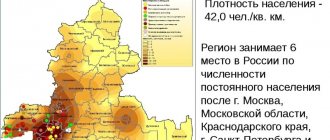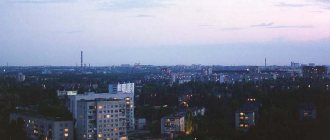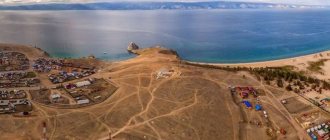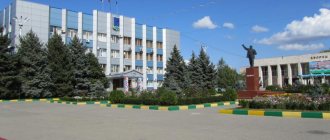Dear residents of the city of Taganrog. And also his guests!!
In this article, we will try to highlight the main districts in the city of Taganrog, which will allow you to understand more clearly, in detail and in detail: what districts the city of Taganrog is divided into, and what subdistricts exist in the main districts of the city of Taganrog.
This is important, since the actual zoning of the city of Taganrog differs from the legal, “standard” one - approved by the General Plan of the city!!
According to the city general plan, there are 5 districts of the city (see below):
- Central area - Located from the port to the lane. Smirnovsky. It houses the vast majority of historical, cultural and architectural monuments with a strict regime of protection and restoration. It allocates an area with regulated development while maintaining the planning grid - from the street. Chekhov, per. Gogolevsky and southwest to the coast.
- Northern district Located north of the railway from the New Railway Station. The unofficial name of the area is SZhM.
- Western district – Located from Chucheva street, from st. Transport and along the Mariupol highway and the airfield of the military unit and airfield 325 ARZ
- The eastern region is a very large area.
- Northwestern region - located east of the Taganrog - Pokrovskoye road - Pokroskoye is the main village of the Neklinovsky district, Rostov region (District center)!!.
- There is also the Neklinovsky district - a huge formation in territory, legally an autonomous entity "Neklinovsky district of the Rostov region" with its center in the village of Pokrovskoye - adjacent to the city of Taganrog, but, basically, economically and infrastructurally completely “tied” to the municipal formation of the city of Taganrog! !
Below we will carry out the zoning of the city of Taganrog, which is the guideline for most citizens and guests coming to the city of Taganrog:
We are sure that this will greatly help everyone choose real estate in Taganrog more easily and correctly, and will also help residents of other regions of the Russian Federation who come to Taganrog on vacation!!!
1) Central region.
It includes mainly low-rise and private houses with separate “interspersed” buildings of the Soviet era: “Khrushchev”, “Brezhnev”, as well as apartment buildings built from 1995 to the present time!!! Also in this area there is a lot of historical knowledge, architectural and cultural monuments of all-Russian significance!! The Taganrog City Administration and most of the “locations” of city authorities are located here!
The boundaries of this area are huge: from Smirnovsky Lane, Gogolesky Lane area, Shevchenko Street, Anton Glushko Lane, Petrovskaya Street area, the area adjacent to Krepotstnaya Lane, the Southern Federal University area, the area adjacent to the Central Market, the Old Station area, Aleksandrovskaya Street , Marmalade shopping center area, Grecheskaya street, Central beach, Central House of Public Services, Seaport area, Primorskaya embankment, A. Kruysa street!!!
Taganrog
History of Taganrog
Archaeological finds indicate that settlements of unknown peoples on the shores of the Taganrog Bay already existed in the Late Bronze Age, about 4 thousand years ago.
The ancient Greeks called the Sea of Azov Meotida, ancient Russian legends called the Sea of Surozh, Lukomorye. In the 5th century BC. e. The ancient historian Herodotus mentioned a seaside Greek colony called Emporion Kremnoi, founded on the site of modern Taganrog. It also conveys the legend that the Amazons once lived here. The first confirmation of Herodotus's message about the city was the chance finds of ancient Greek ceramics during excavation work in the 30s of the last century. But only in the early 2000s, a joint expedition of Russian and German archaeologists discovered the remains of stone buildings and about 20,000 fragments of Greek ceramics from the 7th century BC in the area of the city embankment. e. Artifacts allowed scientists to claim that the region’s oldest ancient settlement of colonists from Eastern Hellas existed here. This policy flourished for about a hundred years, and then was probably destroyed by the rulers of the surrounding steppes - the Scythians. You can get acquainted with archaeological finds in the city local history museum.
The modern name of the city was given by the high rocky cape Taganiy Rog, protruding far into the waters of the sea bay. Tagan is a Turkic word, it means a brazier, and the Slavs called the coastal ledges a horn. Perhaps on this cape there once stood a lighthouse with a signal fire burning on its tagan. In 2005, the remains of a Turkic tandoor oven for baking bread and fragments of pottery from the times of the Khazar Kaganate (650-969) were discovered here.
In the 13th century, Italian colonists, probably sailing from Tuscany, built the port and fortification of Porto Pisano here. This is evidenced by medieval written sources and a nautical map of 1318, on which this city is marked.
In the 70s of the 15th century, the lands were captured by the Ottoman Turks, but two centuries later the Muscovite kingdom entered into confrontation with the Ottoman Empire for this region. The Russians sought to expand their borders to the south and strengthen themselves on the sea shores. After the Turkish stronghold of Azov was defeated by the troops of Peter I, the tsar ordered the foundation of a fortress on Cape Taganiy Rog. The order of the Pushkar order to begin construction is dated September 12, 1798. This date is celebrated in Taganrog as City Day.
In one of her letters to Voltaire, Empress Catherine II recalled that Peter I had been thinking about moving the capital for a long time, choosing between northern St. Petersburg and southern Taganrog. Although Taganrog never had the chance to try on the crown of the southern capital, it was nevertheless the first city in the empire built according to a clear general plan, and the local seaport became the first naval base in the history of Russia. Straight streets start from the place where the legendary Trinity Fortress once stood, and, following the expanding topography of the cape, fan out to the mainland part of the development. The main street of Taganrog is Petrovskaya, it is named after the founder of the city.
At the end of the 60s of the last century, railway tracks stretched here, connecting Taganrog first with Kharkov, and then with Rostov-on-Don, Moscow, St. Petersburg and other cities of the empire. The provincial town turned into a major economic center, factories and factories appeared here, mechanical engineering and metallurgy developed, and maritime trade flourished. Coal, grain and rolled metal were exported. The growing flow of merchants arriving in the southern city via the new railway gave a powerful impetus to Taganrog trade. So many shops appeared on the square in front of the station that it was called the Fair.
To build their houses, wealthy citizens invited talented architects who designed buildings following the architectural fashion of their time.
During the Crimean War of the mid-19th century, which reached the Azov region, the Taganrog garrison repelled an attempt by the Anglo-French fleet to land troops here. During the Great Patriotic War, fierce land battles and naval battles with the Nazis, who were rushing to the Caucasus, unfolded in the city area. For the heroism shown by its residents, in 2011 Taganrog was awarded the honorary title of the City of Military Glory of Russia.
Geography and climate
The cape on which Taganrog is located is a hilly wedge, rising 60-75 m above sea level. From the southwest, the cape is washed by the waters of the Taganrog Bay, and the Miussky Estuary splashes in the southeast. Its sandy muddy spits are washed up by the Mius River, which flows into the Sea of Azov in the vicinity of the city. Two small rivers flow within the boundaries of Taganrog - the Big Turtle and the Small Turtle. A few tens of kilometers to the east is the mouth of the deep Don and the regional center, the city of Rostov-on-Don. Due to river flow, the water in the bay is almost fresh, devoid of salts, but the concentration of iodine, organic matter and minerals in it is increased. The local waters are rich in fish, which are attracted by the nutritious silt.
Here the East European Plain ends, the vast Donetsk steppe meets the sea, air currents create a constant breeze. Its speed is low - 2.8-3.2 m/s. The air is saturated with the smell of the sea and the aromas of steppe herbs. On summer days, a warm breeze blows from the sea; at sunset, the wind changes direction and blows from the shore towards the sea. At dawn the air cycle repeats, and by nine o'clock in the morning the wind from the sea again prevails.
In the summer heat, the shallow Taganrog Bay warms up greatly; by July the water temperature reaches +28 °C, and marine vegetation rapidly develops in the bay, and especially in the estuary. The surface of the water is covered with small blooming algae; at night they fluoresce, giving the sea a fabulous look. Perhaps this is exactly how A.S. Pushkin saw it, who populated these places with the heroes of Lukomorye in his “The Tale of Tsar Saltan.”
The climate in the city is mild; meteorologists did not note any sharp temperature changes. The dryness of the warm steppe air is balanced by the proximity of the sea. Winters in Taganrog are mild by Russian standards, the temperature rarely drops below –15…–12 °C. Spring arrives “on schedule”, at the beginning of March. In May, the air temperature rises to +17…+20 °C. In early June, the air warms up to +24...+25 °C, and the water - up to +20...+22 °C. The townspeople open the swimming season, although it often rains during this month. The driest and sunniest month in the city is August, when the thermometer points to +30...+35 °C. The temperature record in Taganrog is +40.5 °C. The velvet season ends by the end of September. In October it is already chilly, and in November the temperature drops below zero and winter begins. As a rule, the temperature fluctuates between –7…–2 °C. Frosty and snowy in January and February.
Sights of Taganrog
Tourists arriving in Taganrog by train, from the very first steps, get acquainted with one of the city's attractions - the ancient building of the passenger railway station. It was erected in 1869, as soon as the “cast iron” was brought to the strategic port on Azov. The building is made of red brick, in the then fashionable eclectic mixture of architectural styles, but the building looks harmonious. Brick patterns do not require plaster; the range of colors is created by orders of different shades. Near the walls of the station, on a short rail track, there is a steam locomotive from the beginning of the last century. The memorial plaque recalls the events of the Civil War in Russia.
The entrance to the Old Town is marked by a granite obelisk and an ancient border barrier on Grecheskaya Street. The city limits began here in the 19th century.
Tourists walking along the central street of Frunze pay attention to entire blocks of colorful buildings of venerable age that have been preserved here. Among them, the mansion at number 20 stands out, built in the 60s of the 19th century and known as the Rafailovich House. Its façade with a high plinth is decorated with stucco bas-relief medallions and vases in which Greek and Roman motifs are recognizable. The building's outline and striking decor skillfully combine elements of several architectural styles.
According to art critics and local architectural historians, this is one of the most beautiful buildings in Old Taganrog. Experts included it in the list of Russian cultural heritage sites.
One of the most famous buildings in the city is a modest one-story building on Grecheskaya Street, built in 1806. There were apartments here for especially important guests of the city government, where Emperors Nicholas I, Alexander II and Alexander III, the Grand Dukes of the reigning Romanov dynasty, and outstanding Russian artists and writers stayed. Among them are A. S. Pushkin, V. A. Zhukovsky, I. K. Aivazovsky. In 1825, the family of Emperor Alexander I settled in this house. On November 9, the emperor suddenly died; his sudden death gave rise to many rumors and legends. One of the folk legends about this dramatic event claims that the tsar only staged his death far from the capital St. Petersburg, but in fact disguised himself as a commoner and went on a journey. Connected with this legend is the mysterious personality of Elder Fyodor Kuzmich, who appeared in Siberia at the same time. They say that the king, shortly before leaving the capital, expressed his intention to abdicate the throne and retire to a monastery.
Empress Elizaveta Alekseevna ordered a home church to be built in the room where her husband died, and the guest house itself to be called the Palace of Alexander I. This is what this house is still called today.
Further on Grecheskaya Street, your attention will be drawn to an ancient mansion marked with a marble memorial plaque. It is known as the Tchaikovsky House. Here lived the naval officer Ippolit Ilyich Tchaikovsky, the brother of the great composer, who sometimes stayed here and worked in this house on his symphonic works. Now the building houses the Tchaikovsky Museum and a public library, and the small concert hall often hosts musical evenings that are worth a visit for fans of classical melodies.
On Chekhov Street there is a house-museum of this famous writer. The entrance ticket costs 60 rubles. The cozy tiny rooms recreate the interiors of the second half of the 19th century. And in the well-kept garden at the entrance to the museum, strolling... Anton Pavlovich himself! This is a local theater actor, made up to look like Chekhov. Tourists are sure to take photos in his company. Next door there is a shop with a large selection of souvenirs. The Chekhov Literary Museum is located in the building of the gymnasium where the writer studied. Another object associated with his name is the trading shop of Chekhov’s father not far from the station, where during the summer holidays the young high school student Anton Chekhov, the future classic of world literature, often stood behind the counter. In the cramped space of the Chekhovs' shop, the guide's interesting story is accompanied by tea drinking.
The city museum of local lore occupies an old two-story mansion. The exhibition, located in its 13 halls, introduces the history of the Azov region. Unique archaeological artifacts are demonstrated in the recreated burial complex of the Alan queen, who ruled at the beginning of the 1st millennium.
Above the sea, where the Trinity Fortress once stood, there is a well-groomed square. A bronze monument to the founder of the city, Peter I, is erected here. The Emperor is depicted in the uniform of an officer of the Preobrazhensky Regiment. A.P. Chekhov took an active part in the creation of the monument. In the early 80s of the 19th century, the writer went to France, where the famous Russian sculptor Mark Antokolsky lived at that time, and agreed with him to create a monument based on the model that was demonstrated at the Polytechnic Exhibition in Moscow. The sculpture was cast in bronze in Antokolsky's workshop in Paris and delivered by ship to Taganrog for the 200th anniversary of the city, celebrated in 1898. Under Soviet rule, the monument was dismantled, but, fortunately, not destroyed. The sculpture was kept in the city museum for several decades, and in 1958 the monument to Peter I was restored.
On the Greek street there is a sundial, the oldest of such “eternal” chronometers preserved in Russia. They were installed in 1833, and all the celebrities who visited Taganrog since then certainly came here, checking their watches with solar time. The shadow of the vertical bronze triangular gnomon indicates daytime, following the Sun across the carved marble dial. In 2000, to commemorate the beginning of the new millennium, at the entrance to the park. Gorky, another sundial was installed, manufactured at one of the Taganrog enterprises.
A monumental stone staircase 113 meters long, built in 1823, leads to the city embankment. It contains 188 massive steps made of light brown granite; on the slopes there are passages to observation platforms with decorative fences, from here you can enjoy beautiful views of the sea. You can take a break on the climb at a table in one of the mini-cafes.
The elegant Pushkinskaya embankment is paved with stone paving stones and decorated with green lawns and flowering flower beds. Several monuments have been erected here.
At the foot of the staircase there are three closed columns made of pink granite, symbolizing three centuries of Taganrog's history. The columns are crowned with a bronze sculpture of the city's guardian angel. From here, radial paths are laid through the square. One of them will lead you to the original sculptural composition “Romance with a Double Bass”. The author was inspired by the story of the same name by A. Chekhov. Citizens and tourists love to take pictures here. There are other sculptures of literary characters from Chekhov’s stories in the city – “The Lady with the Dog”, “The Thick and the Thin”, “The Man in a Case”.
The alley located to the right leads to the monument to A.S. Pushkin. The poet visited the city in June 1820, during his trip to Southern Russia. Every year in May, Pushkin readings are held at the monument, where poets recite their poems.
Not far from the city yacht club there is a monument to the national hero of Italy, General Giuseppe Garibaldi. In his youth, Garibaldi was a sailor, and on the sailing ship “Clorinda” he visited Taganrog more than once on trade matters. It was here in 1833 that he met a group of Italian political emigrants and joined the revolutionary organization Young Italy, which was developing plans to liberate his country from Austrian oppression and proclaim an independent republic. In 2007, when the 200th anniversary of the birth of Garibaldi was celebrated, a delegation from Italy visited Taganrog. Among the guests was the hero's great-granddaughter, Annita Garibaldi-Zhalet. And soon a gift was sent from Milan - the painting “Garibaldi in Taganrog”. It can be seen in the exhibition of the city local history museum.
Near the Marine Station there is a monument to the sailors of the Azov Military Flotilla. On a concrete pedestal made in the form of stylized waves, there is a combat boat that defended the city during the Great Patriotic War.
Few people know that on the western outskirts of Taganrog, on the territory of a military unit, there is a military airfield and an aircraft museum. Here you can examine 12 combat and transport aircraft, a helicopter, samples of winged aircraft weapons, pilot ejection seats, and pilot equipment. Of particular interest is the Be-12 amphibious aircraft. This flying boat was designed to hunt enemy submarines. By the way, the design bureau named after. G. Beriev, where the aircraft was created, is located in Taganrog.
The only one of its kind is the Mig-25 BM attack aircraft; only four dozen such aircraft were built. The caretakers will be happy to tell you about the features of each flying car. The museum is open from 08:00 to 14:00. A visit must be arranged in advance; to organize such an excursion, you can contact the administration of the Youth Palace.
Of the churches in Taganrog, the most revered is St. Nicholas Church, also known as the Church of St. Nicholas the Wonderworker. It was erected in 1778 in the name of St. Nicholas, the patron saint of seafarers, in a seaside fishing village, for the spiritual needs of the sailors of the Azov military flotilla. Now the village has become one of the city's microdistricts. Tradition says that the church was founded on the very spot where the camp tent of Tsar Peter I once stood. A shrine with the relics of St. Paul of Taganrog is kept in this temple. In Turgenevsky Lane, the house where the elder’s cell was was preserved; today it has become a place of pilgrimage. One of the bells was cast from bronze Turkish cannons captured by Russian troops in battle.
Beaches
There are quite a lot of good beaches in Taganrog itself and its immediate surroundings. Almost all of them are sandy, shallow, with a gentle entrance to the sea. Access to city beaches is free; beach equipment rental is not offered everywhere.
The townspeople consider the sunny beach the best in Taganrog. It is located at the end of Pushkinskaya Embankment. Here is the epicenter of youth nightlife; nearby there are discos, popular restaurants and bars open until the morning. On Sunny Beach, vacationers will find several water attractions, a swimming pool, a billiards room, inflatable boat rental centers are open, and a playing field for beach volleyball is equipped. There are trampolines and inflatable slides for children. Snack bars offer light snacks, and you can have a hearty meal in beach cafes. The Lazurny water park is located nearby.
The most comfortable one in Taganrog is Eliseevsky Beach. It also borders a water park. Here you can rent sun loungers and umbrellas, equipment for water entertainment - catamarans, banana boats. In the evenings, concerts are held on the stage by the sea.
The Central Beach in the historical part of Taganrog can be reached by tram No. 8 or minibus No. 73. A walk to the beach from Petrovskaya Street will take a quarter of an hour. On the wide shore there are changing rooms, showers, cafes, and toilets.
Primorsky Beach is located in a park area on the outskirts of the city. The sea here is shallow, so families with children come here. There are changing rooms on the beach and umbrella rentals are available. There is a windsurfing school here, where instructors teach beachgoers the art of boarding with a sail. The park, also called Primorsky, has a summer cinema, attractions, and a cafe overlooking the sea.
A few kilometers from Taganrog you can retire to the “wild” beaches. Local residents often go there to fish, cook fish soup over a fire, or barbecue on improvised grills.
On the sea estuaries in the vicinity of the city there are areas with healing mud. This healing ingredient is used in the balneological departments of local sanatoriums, and can be purchased in city pharmacies.
Active recreation in Taganrog
Fans of active recreation will not be bored in Taganrog, especially those who like water sports. In the area of the seaport there is a yacht club founded in 1908. Here you can go yachting, kayaking and canoeing, and rent a boat hourly or daily for boat trips and fishing. Every year, races of sailing ships of various classes start from here; thousands of citizens and tourists come to Pushkinskaya Embankment to admire this spectacular spectacle. Competitions of radio-controlled yacht models are also held here. The yacht club building has a restaurant and billiards.
Passenger ships departing from the Seaport for cruises on the Azov and Black Seas, and a cruise line operates on the Don River. Cruise ships of the "river-sea" type ply along the route Moscow - Taganrog - Moscow.
There is a windsurfing club “Southern Sails” on Primorsky Beach. The flying club, located on Aviator Square, 1, offers flights on sports aircraft and parachute jumps. You can take part in auto racing on the track of the Formula karting club on Admiral Kruys Street.
The Skif paintball club organizes bloodless shootouts at a country training ground near a picturesque lake. On Tolbukhin Street, 7, the courts of the Tennis Academy await athletes.
The city has well-equipped gyms and fitness centers. Travelers with sporting inclinations will be interested in the Lady Fitness club (1st Krepostnoy Lane, 5). A cosmetologist works here, there is a manicure room, and group aerobics sessions are held. The women's club "Indigo" (Initiative Street, 54-A) offers yoga classes, oriental dance classes, and a herbal bar.
The clubs “Jamo” (26 Petrovskaya Street) and “Karambol” (241 S. Shilo Street) invite you to play billiards. On Syzranova Street, 11, there is the Neo bowling club.
If your hotel does not have a sauna and swimming pool, go to the Bodrost health complex (Chekhova Street, 110). There are Russian, Finnish and Turkish baths, massage rooms, a warm pool, and a jacuzzi. The Priboy complex (Bolshaya Bulvarnaya Street, 13) has a sports swimming pool, diving towers, a diving school, and water aerobics trainers. There are also Russian baths, a solarium, and a fitness center here. The Podvorye bathhouse complex on Mariupolskoye Highway has a Russian bathhouse in a wooden frame, a cozy gazebo and barbecue facilities.
There are several rental points for mountain and sports bikes in Taganrog; they are located in the center, on Grecheskaya Street.
Entertainment
Some evening, be sure to go to a performance at the Drama Theater named after. Chekhov, his troupe is considered one of the best in Southern Russia. Take a look at Gorky Park, where concerts and entertainment programs are held on the stage of the Green Theater in the evenings. Interesting performances are performed by artists from the Youth Theater on Petrovskaya, 104. The theater opens in the evenings, from 18:00. Take your children to the Cheshire Cat puppet theater on Grecheskaya Street. Performances are held daily from 09:00 to 19:00. There is another puppet theater in the Festivalny House of Culture on Lenin Street, and the Azovye Circus is located on Chekhov Street, 100.
Viewers are invited to the city's modern cinemas. The largest of them is the Charlie cinema, which has 7 halls in the Marmalade shopping center on Peace Square.
You can continue your evening entertainment program in Taganrog nightclubs. Club STAGE karaoke & show is open in the shopping and entertainment building (Mira Square, 7) from 18:00 to 06:00. From 21:00 to 06:00 the club-restaurant “Art Hall” (Dzerzhinsky Street, 161) is open.
On Sunny Beach from 21:00 to 05:00 the Infinity Club invites you to night swimming and fun parties. On Bolshaya Boulevard Street, 23, in the Cosmos club, the evening show starts at 21:00 and ends at 05:00.
Purchases
Modern shopping and entertainment centers have been built in Taganrog, the range of their goods is in no way inferior to the shops of large Russian cities. The only specific thing is that Taganrog stores offer a wide selection of related products for tourists and holidaymakers vacationing in the city. Here are the addresses and opening hours of several shopping centers located in the center.
- Shopping center "City Center", 10:00-21:00 (Gogolevsky lane, 2);
- Shopping center "Andreevsky", 10:00-21:00 (Petrovskaya street, 89);
- Shopping center "Kryudor", 10:00-22:00 (First New Lane);
- Shopping center "Moscow", 10:00-22:00 (Dzerzhinsky Street, 165-B).
Four large food markets in coastal Taganrog offer a good selection of fresh seafood, salted and dried fish, crayfish, smoked meat and fish, balyk, fresh vegetables and seasonal southern fruits throughout the summer season. One of them, Privokzalny, is located near the new Taganrog-1 railway station. The Central Market is the busiest; it is located on the corner of Chekhov Street and Gogolevsky Lane. Other bazaars are located in remote residential areas.
As delicious souvenirs, city guests buy dried and smoked fish products, as well as locally produced sweets - marmalade, waffles, marshmallows, and cookies.
The healing mud of local estuaries is popular; it is sold in packaged form in stores and pharmacies.
Taganrog Restaurants
Taganrog has no shortage of cafes and restaurants. The cost of a hearty lunch in numerous city cafes is around 200 rubles. Among these catering establishments, several of the most popular among city residents stand out. These include the “Red Poppy” cafe-confectionery, where several generations of Taganrog sweet tooths have visited over half a century since its opening. The most delicious desserts in the city are served here, branded confectionery products are baked in the kitchen according to recipes from the 60s of the last century, and excellent coffee is brewed. The average bill without drinks does not exceed 220 rubles per person. The confectionery is located in the historical center, at 68-A Petrovskaya Street, opening hours are 09:00-21:00.
Another iconic cafe is “Freken Bok”, its interior is decorated with images of the cartoon characters “The Kid and Carlson, Who Lives on the Roof”. In the center is a photograph of the famous native of Taganrog, actress Faina Ranevskaya, in whose voice the cartoon “housekeeper” Miss Bok speaks.
The Paradise by the Sea cafe is famous for its excellent cuisine and reasonable prices. There are two halls, one of them has hookahs and a dance floor. Tables are also located on the spacious veranda overlooking the sea. The gastronomic highlight of this establishment is fish and meat fried over coals, accompanied by a side dish of baked vegetables. Among the appetizers are Russian pickles. The average check per person is 500 rubles (without drinks). Visa and MasterCard bank cards are accepted for payment.
The panoramic restaurant “Zhemchuzhina” on Pushkinskaya Embankment is famous for the original dishes of an excellent chef. The average bill will be at least 1,000 rubles per person (excluding alcohol).
Where to stay
One of the best hotels in the city is Park-Hotel Malikon 4*. Nearby there is a park named after. 300th anniversary of Taganrog, trading. The nearest beach is within walking distance. The hotel has secure parking, a bar, and two swimming pools. The restaurant serves Caucasian and Russian cuisine. Accommodation in a standard double room will cost 2,400 rubles per day, in a luxury room – 3,230 rubles.
In the center of Taganrog, a ten-minute walk from Pushkinskaya Embankment, a modern, comfortable Temirinda Hotel & Spa 4* was recently built. The hotel has a restaurant and bar, spa, swimming pool, sauna with massage room. Breakfast is included in the price. Children under 3 years old stay free.
On Petrovskaya Street, in a two-story mansion of the 19th century, the Bristol 3* hotel is located. On the ground floor there is a restaurant and cafe. Upon request, guests can have breakfast or lunch delivered to their room. The main city attractions are within walking distance. The cost of living is from 2200 rubles per day.
"Congress Hotel" 3* has a restaurant with European cuisine, a 24-hour lobby bar with a good selection of drinks, salads and desserts. There are billiards and bowling alleys, an infrared sauna, a massage room, and a beauty salon. The cost of living is from 1545 rubles.
In the central district of Taganrog, in a restored ancient building, the Assol 3* hotel is located. City attractions are nearby. The rooms are spacious with high ceilings. Transfer to Rostov-on-Don Airport is available upon request. The cost of living is from 1970 rubles per day.
Tourists on a limited budget can stay at the Nika Hotel, located three kilometers from the center and sea beaches. Accommodation in a single room will cost 1,180 rubles, in a double room – 1,290 rubles per day.
You can inexpensively rent a room in the Forsazh guest house, located on Oktyabrskaya Street, about a kilometer from the city center. The cost of living is from 1390 rubles per room.
The non-smoking guest house Renaissance is located nearby. The cost of living starts from 1445 rubles.
The original building of the Plotnikovs' guest house was built in the very center of the city. There is no smoking here either. The hotel has a bar serving drinks and snacks, and there are restaurants nearby. The cost of living is from 2120 rubles per day.
There are several agencies in Taganrog offering tourists rental apartments within walking distance from the sea, city beaches and parks. Some of them, for a rental period of 5 days or more, provide meeting guests at the Rostov-on-Don airport and return transfer, providing these transport services free of charge. The cost of living in a one-room apartment with two beds starts from 800 rubles per day. A two-room apartment with four beds in the central area can be rented for 1,000 rubles/day, a three-room apartment with six beds will cost 1,500 rubles/day.
Booking.com
Recreation centers and sanatoriums
Within the city there are several sanatoriums with comfortable 2-3-bed rooms, three meals a day and medical services.
The health and wellness center provides treatments with healing mineral water from a 140-meter well. Diseases of the cardiovascular system, musculoskeletal system and other pathologies are treated here. The cost of accommodation with a course of treatment and meals is 900 rubles per person per day. Address: 14th Artillery Lane, 21-A. Travel from the railway station by buses No. 31 and No. 35.
The Topol sanatorium is built on the seashore; the resort has its own beach with canopies and sun loungers, an outdoor swimming pool, a sauna, and a gym. On a well-groomed park area of 4 hectares, there are health paths, there is a Tea Club, a cinema hall, a library, and a Kaleidoscope family park with attractions for children. There is also a restaurant, a souvenir kiosk, selling soft drinks, ice cream, and sweets. The sanatorium offers rooms of several categories with TVs, refrigerators, and spacious loggias. Accommodation in a standard double room will cost 3170 rubles/day (breakfast is included in the price).
Transport
Urban transport in Taganrog is represented by buses, minibuses and taxis, and the tram and trolleybus networks are well developed. The cost of a ticket for travel on trams and trolleybuses is 14 rubles. The construction of electric transport lines to remote residential areas continues.
The price of a bus subscription is 16 rubles. The same amount is established for minibus passengers. City vehicles serve 35 routes.
The average cost of a taxi ride in the central regions is about 100 rubles. It is convenient to order a taxi through the hotel administrator.
How to get there
There are no direct flights to Taganrog. The nearest airport is in Rostov-on-Don, 60 km from Taganrog. The flight from Moscow lasts about 2 hours, the ticket price starts from 2,500 rubles. Then you can continue your journey by bus or electric train. The railway and bus stations of Rostov-on-Don are located on the same station square. From the airport they are served by bus No. 7, trolleybus No. 9, minibus No. 52. A trip to Taganrog by taxi will cost about 1,500 rubles.
By rail, you can get from the capital to Taganrog on southern trains, for example Moscow - Adler or Moscow - Anapa, departing from the platforms of the Kazansky railway station. Travel time is 16 hours, ticket price is from 2,000 rubles.
From Moscow to Taganrog you can take a bus departing from the Orekhovo metro station. The ticket price is 1,350 rubles, travel time is 17 hours. Every three hours the bus makes a short stop for passengers to warm up. Video films are shown in the salon.
If you want to travel from Moscow to Taganrog in your own car, take the MKAD onto the M4 highway and head south. The road surface is in satisfactory condition, there are quite a lot of gas stations and cafes along the way. The distance between the cities is 1174 km; without haste, the journey will take 16-18 hours.
2) Western region.
The largest district in terms of population is Taganrog. It includes the following areas: Russian Field, Prostokvashino, Military Town, the area adjacent to the Nikolaevsky Market, the area of Bolshaya Boulevard Street, the area of Transportnaya Street, Sergei Shilo Street, Lomonosov Street, Teatralnaya Street, the Mariupol Highway area!!
Now the Aviator microdistrict, an area of new construction with three-story new houses, is conditionally included in the “Zapadny” district, but legally it belongs to the Neklinovsky district!!! Although it is practically “tied” to the infrastructure of the city of Taganrog!!
So, after all, is Taganrog Russia or Ukraine?
This beautiful city occupies a very important place in Russian history. And not only. 1918 Taganrog is the capital of the People's Republic of Ukraine. How? Why?
All this happened for a reason, but had its prerequisites. First of all, if we take the entire district at that time, then Ukrainians made up 71.5% of the total population, although in the city itself there were 34.6%. Russians – 21.9% and 55.2%, respectively. Therefore, there is nothing strange about this.
Secondly, in 1918, almost all of Ukraine was occupied by the Kaiser’s Germany, and there was simply no place for the government to work there. And then a special decree stipulated the Ukrainian status of Taganrog. And then a special plebiscite was held. As a result of all this, the city became Ukrainian for some time, albeit a short one. The government bodies of the entire state were located and worked in it. That is, it turned out to be a capital, and it fully corresponded to its high rank. After some time, Taganrog lost it, but remained part of Ukraine.
Let's answer the question of where Taganrog is now, in what country. The answer is short and specific - in Russia.
5) Primorsky district
Primorsky district is a small area adjacent to Primorsky Park. This is the area adjacent to Svoboda Street, the area of the 10th lane, the area adjacent to the Torpedo football stadium, the area of Bezymyanny Proezd (the so-called Bezymyanka), the area of Krasnogvardeisky Lane, Instrumentalnaya Street, Komabaynovy Plant, the Beriev TANTK plant, Lomakin Street, the area - adjacent to the Taganrog Vodokanal.
In the photo there is a monument to the founder of the city - Peter the Great!!
For all questions regarding real estate in the city of Taganrog and surrounding areas, please contact our company!!







